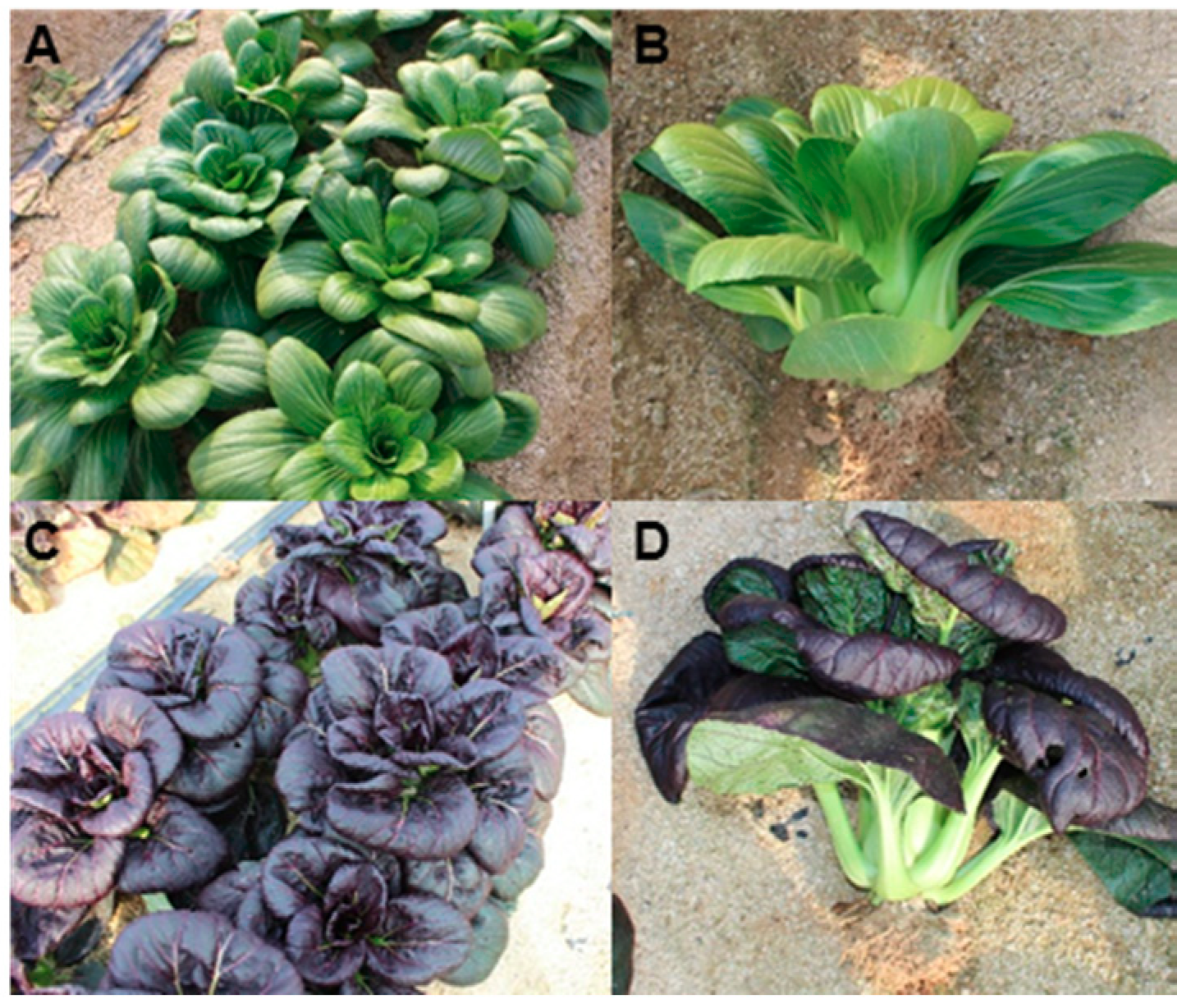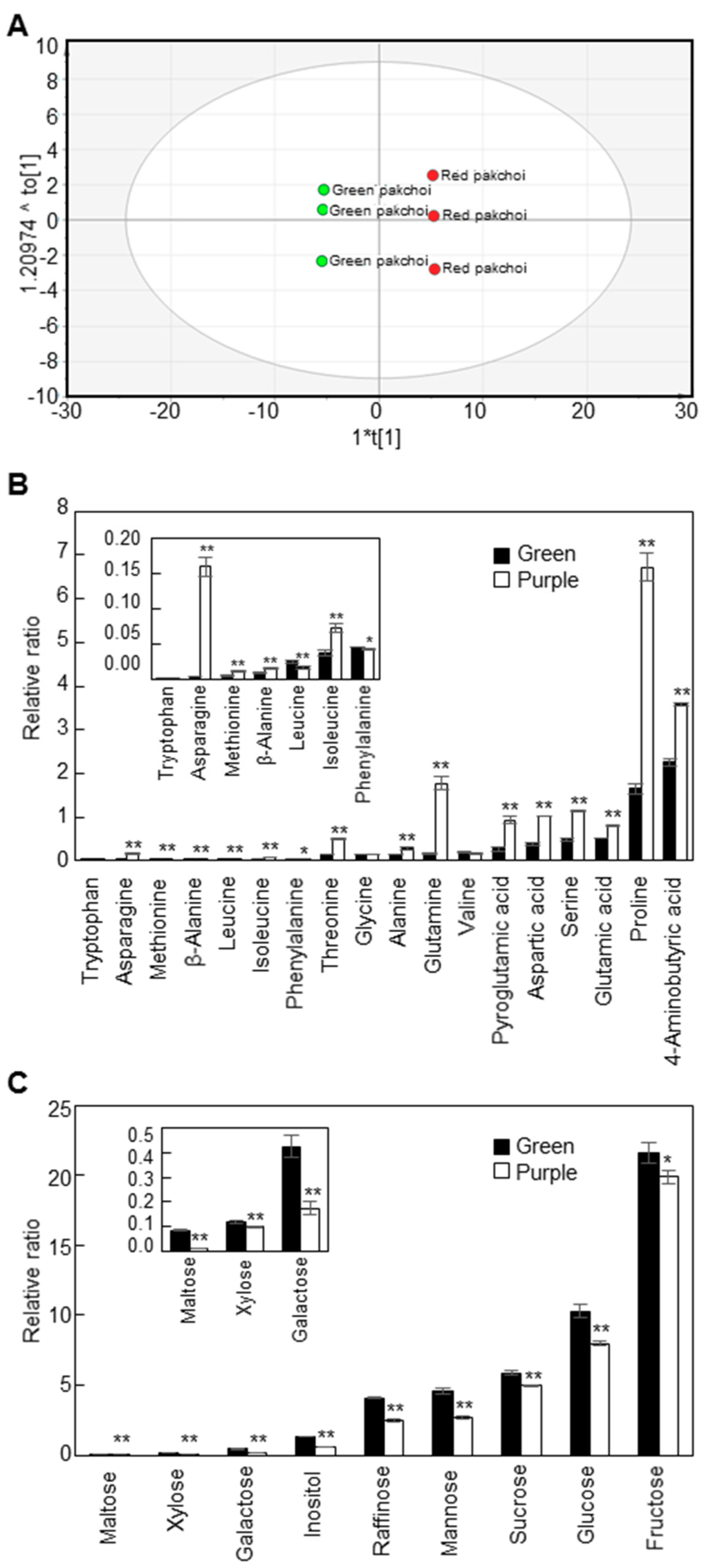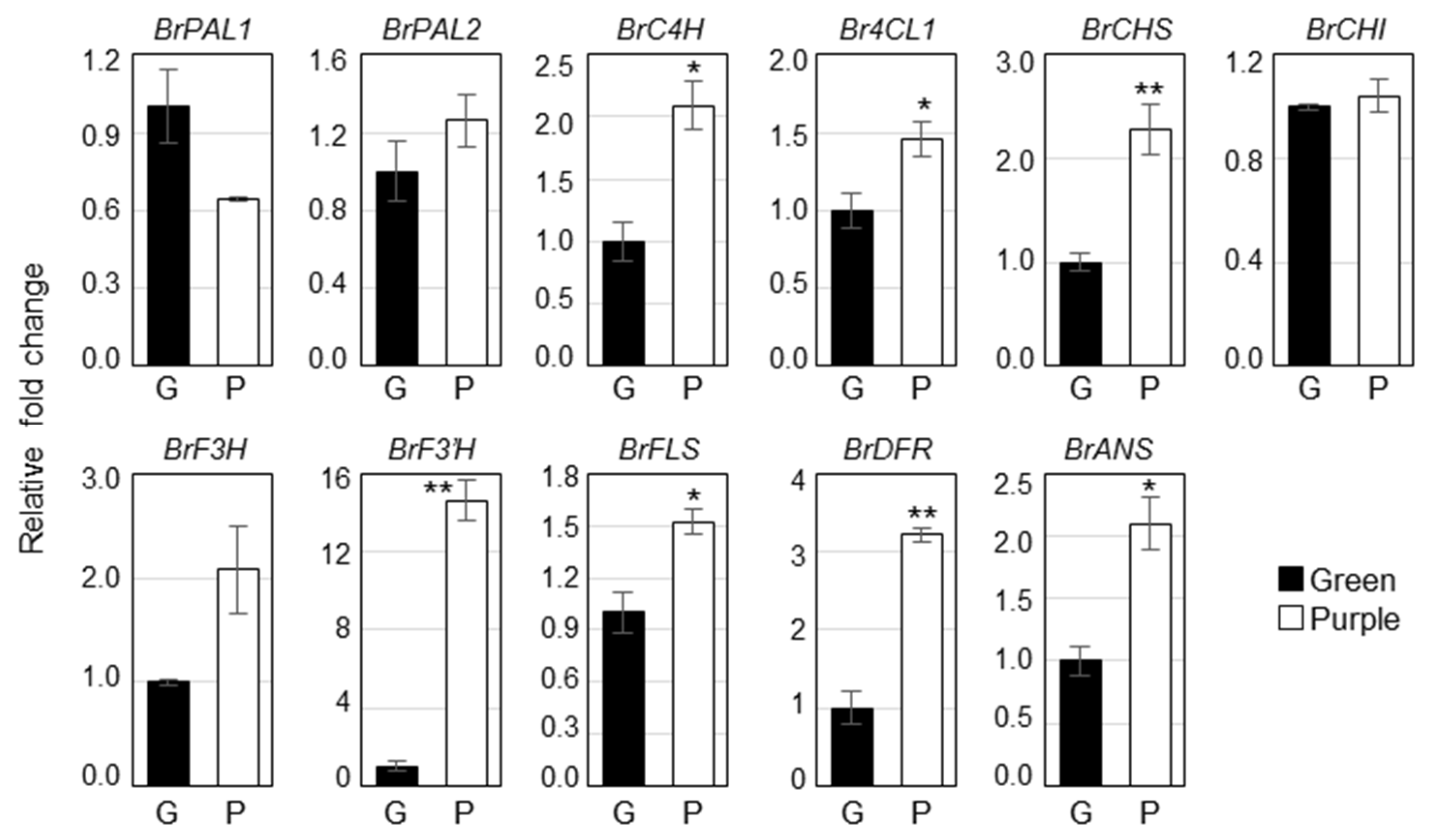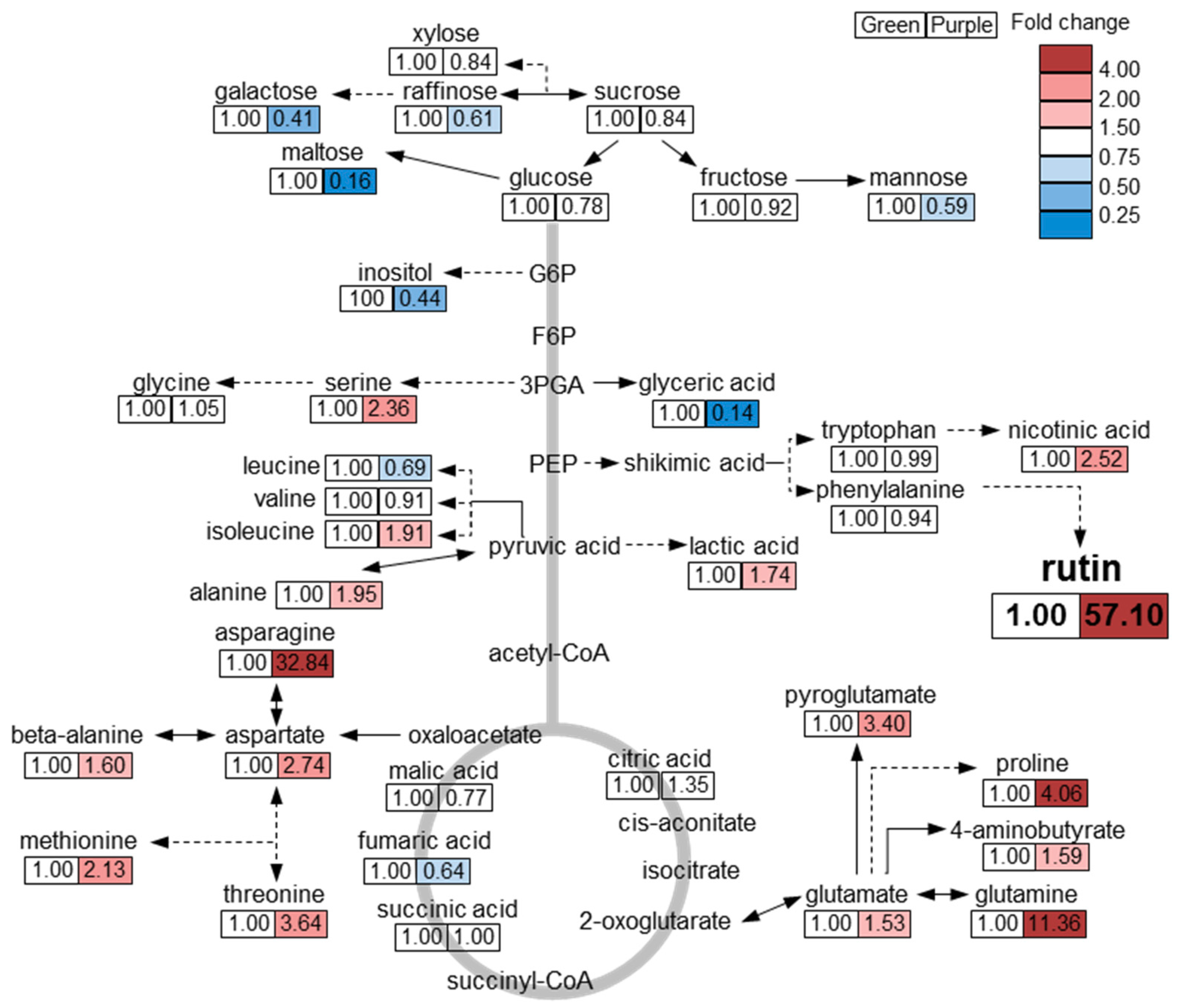Comparative Metabolic Profiling of Green and Purple Pakchoi (Brassica Rapa Subsp. Chinensis)
Abstract
1. Introduction
2. Results and Discussion
2.1. Analysis of Polar Metabolites in Green and Purple Pakchoi
2.2. Identification of Phenylpropanoid Biosynthetic Genes in Pakchoi Cultivars
2.3. Analysis of Phenylpropanoid Contents in Green and Purple Pakchoi
2.4. Analysis of Anthocyanin Contents in Green and Purple Pakchoi
3. Materials and Methods
3.1. Plant Material and Growth Conditions
3.2. Polar Metabolite Profiling by GC-TOF MS
3.3. RNA Extraction and QRT-PCR
3.4. Extraction and HPLC Analysis of Phenylpropanoids
3.5. Extraction and HPLC Analysis of Anthocyanins
3.6. Statistical Analysis
4. Conclusions
Supplementary Materials
Author Contributions
Funding
Conflicts of Interest
Abbreviations
| HPLC-UV | high-performance liquid chromatography-ultraviolet |
| GC-TOF MS | gas chromatography-time of flight mass spectrometry; |
| HPLC-ESI-MS/MS | high-performance liquid chromatography-electrospray ionization tandem mass spectrometry |
| TMS | trimethylsilyl |
| PCA | principal component analysis |
| OPLS-DA | orthogonal projections to latent structures discriminant analysis |
References
- Cartea, M.E.; Francisco, M.; Soengas, P.; Velasco, P. Phenolic Compounds in Brassica Vegetables. Molecules 2010, 16, 251–280. [Google Scholar] [CrossRef] [PubMed]
- Jahangir, M.; Kim, H.K.; Choi, Y.H.; Verpoorte, R. Health-Affecting Compounds in Brassicaceae. Compr. Rev. Food Sci. Food Saf. 2009, 8, 31–43. [Google Scholar] [CrossRef]
- Park, W.T.; Kim, J.K.; Park, S.; Lee, S.W.; Li, X.; Kim, Y.B.; Uddin, M.R.; Park, N.I.; Kim, S.J.; Park, S.U. Metabolic profiling of glucosinolates, anthocyanins, carotenoids and other secondary metabolites in kohlrabi (Brassica oleracea var. gongylodes). J. Agric. Food Chem. 2012, 60, 8111–8116. [Google Scholar] [CrossRef] [PubMed]
- Bhandari, S.R.; Jo, J.S.; Lee, J.G. Comparison of Glucosinolate Profiles in Different Tissues of Nine Brassica Crops. Molecules 2015, 20, 15827–15841. [Google Scholar] [CrossRef] [PubMed]
- Harbaum, B.; Hubbermann, E.M.; Wolff, C.; Herges, R.; Zhu, Z.; Schwarz, K. Identification of Flavonoids and Hydroxycinnamic Acids in Pak Choi Varieties (Brassica campestris L. ssp. chinensis var. communis) by HPLC–ESI-MS n and NMR and Their Quantification by HPLC–DAD. J. Agric. Food Chem. 2007, 55, 8251–8260. [Google Scholar] [CrossRef] [PubMed]
- Harbaum, B.; Hubbermann, E.M.; Zhu, Z.; Schwarz, K. Free and bound phenolic compounds in leaves of pak choi (Brassica campestris L. ssp. chinensis var. communis) and Chinese leaf mustard (Brassica juncea Coss). Food Chem. 2008, 110, 838–846. [Google Scholar] [CrossRef] [PubMed]
- Rochfort, S.J.; Imsic, M.; Jones, R.; Trenerry, V.C.; Tomkins, B. Characterization of Flavonol Conjugates in Immature Leaves of Pak Choi [Brassica rapa L. ssp. chinensis L. (Hanelt.)] by HPLC-DAD and LC-MS/MS. J. Agric. Food Chem. 2006, 54, 4855–4860. [Google Scholar] [CrossRef] [PubMed]
- Zhang, Y.; Chen, G.; Dong, T.; Pan, Y.; Zhao, Z.; Tian, S.; Hu, Z. Anthocyanin accumulation and transcriptional regulation of anthocyanin biosynthesis in purple bok choy (Brassica rapa var. chinensis). J. Agric. Food Chem. 2014, 62, 12366–12376. [Google Scholar] [CrossRef] [PubMed]
- Wittstock, U.; Gershenzon, J. Constitutive plant toxins and their role in defense against herbivores and pathogens. Curr. Opin. Plant Biol. 2002, 5, 300–307. [Google Scholar] [CrossRef]
- Fraser, C.M.; Chapple, C. The Phenylpropanoid Pathway in Arabidopsis. Arabidopsis Book 2011, 9, e0152. [Google Scholar] [CrossRef] [PubMed]
- Herrmann, K.M.; Weaver, L.M. The shikimate pathway. Annu. Rev. Plant Physiol. Plant Mol. Biol. 1999, 50, 473–503. [Google Scholar] [CrossRef] [PubMed]
- Vogt, T. Phenylpropanoid biosynthesis. Mol. Plant 2010, 3, 2–20. [Google Scholar] [CrossRef] [PubMed]
- Li, X.; Thwe, A.A.; Park, N.I.; Suzuki, T.; Kim, S.J.; Park, S.U. Accumulation of phenylpropanoids and correlated gene expression during the development of tartary buckwheat sprouts. J. Agric. Food Chem. 2012, 60, 5629–5635. [Google Scholar] [CrossRef] [PubMed]
- Zhao, S.; Park, C.H.; Li, X.; Kim, Y.B.; Yang, J.; Sung, G.B.; Park, N.I.; Kim, S.; Park, S.U. Accumulation of Rutin and Betulinic Acid and Expression of Phenylpropanoid and Triterpenoid Biosynthetic Genes in Mulberry (Morus alba L.). J. Agric. Food Chem. 2015, 63, 8622–8630. [Google Scholar] [CrossRef] [PubMed]
- Zhao, S.; Tuan, P.A.; Li, X.; Kim, Y.B.; Kim, H.; Park, C.G.; Yang, J.; Li, C.H.; Park, S.U. Identification of phenylpropanoid biosynthetic genes and phenylpropanoid accumulation by transcriptome analysis of Lycium Chinense. BMC Genom. 2013, 14, 802. [Google Scholar] [CrossRef] [PubMed]
- Boyle, S.P.; Dobson, V.L.; Duthie, S.J.; Hinselwood, D.C.; Kyle, J.A.; Collins, A.R. Bioavailability and efficiency of rutin as an antioxidant: A human supplementation study. Eur. J. Clin. Nutr. 2000, 54, 774–782. [Google Scholar] [CrossRef] [PubMed]
- Potapovich, A.I.; Kostyuk, V.A. Comparative study of antioxidant properties and cytoprotective activity of flavonoids. Biochemistry 2003, 68, 514–519. [Google Scholar] [PubMed]
- Tang, D.Q.; Wei, Y.Q.; Gao, Y.Y.; Yin, X.X.; Yang, D.Z.; Mou, J.; Jiang, X.L. Protective effects of rutin on rat glomerular mesangial cells cultured in high glucose conditions. Phytother. Res. 2011, 25, 1640–1647. [Google Scholar] [CrossRef] [PubMed]
- Santos, B.L.; Silva, A.R.; Pitanga, B.P.; Sousa, C.S.; Grangeiro, M.S.; Fragomeni, B.O.; Coelho, P.L.; Oliveira, M.N.; Menezes-Filho, N.J.; Costa, M.F.; et al. Antiproliferative, proapoptotic and morphogenic effects of the flavonoid rutin on human glioblastoma cells. Food Chem. 2011, 127, 404–411. [Google Scholar] [CrossRef] [PubMed]
- Sheu, J.R.; Hsiao, G.; Chou, P.H.; Shen, M.Y.; Chou, D.S. Mechanisms involved in the antiplatelet activity of rutin, a glycoside of the flavonol quercetin, in human platelets. J. Agric. Food Chem. 2004, 52, 4414–4418. [Google Scholar] [CrossRef] [PubMed]
- Ziaee, A.; Zamansoltani, F.; Nassiri-Asl, M.; Abbasi, E. Effects of rutin on lipid profile in hypercholesterolaemic rats. Basic Clin. Pharmacol. Toxicol. 2009, 104, 253–258. [Google Scholar] [CrossRef] [PubMed]
- Nijveldt, R.J.; van Nood, E.; van Hoorn, D.E.; Boelens, P.G.; van Norren, K.; van Leeuwen, P.A. Flavonoids: A review of probable mechanisms of action and potential applications. Am. J. Clin. Nutr. 2001, 74, 418–425. [Google Scholar] [CrossRef] [PubMed]
- He, F.; Mu, L.; Yan, G.L.; Liang, N.N.; Pan, Q.H.; Wang, J.; Reeves, M.J.; Duan, C.Q. Biosynthesis of anthocyanins and their regulation in colored grapes. Molecules 2010, 15, 9057–9091. [Google Scholar] [CrossRef] [PubMed]
- Veitch, N.C.; Grayer, R.J. Flavonoids and their glycosides, including anthocyanins. Nat. Prod. Rep. 2008, 25, 555–611. [Google Scholar] [CrossRef] [PubMed]
- Yang, M.; Koo, S.I.; Song, W.O.; Chun, O.K. Food matrix affecting anthocyanin bioavailability: Review. Curr. Med. Chem. 2011, 18, 291–300. [Google Scholar] [CrossRef] [PubMed]
- Kim, T.J.; Lee, K.B.; Baek, S.-A.; Choi, J.; Ha, S.-H.; Lim, S.-H.; Park, S.-Y.; Yeo, Y.; Park, S.U.; Kim, J.K. Determination of lipophilic metabolites for species discrimination and quality assessment of nine leafy vegetables. J. Korean Soc. Appl. Biol. Chem. 2015, 58, 909–918. [Google Scholar] [CrossRef]
- Ruzzo, E.K.; Capo-Chichi, J.-M.; Ben-Zeev, B.; Chitayat, D.; Mao, H.; Pappas, A.L.; Hitomi, Y.; Lu, Y.-F.; Yao, X.; Hamdan, F.F.; et al. Deficiency of asparagine synthetase causes congenital microcephaly and a progressive form of encephalopathy. Neuron 2013, 80, 429–441. [Google Scholar] [CrossRef] [PubMed]
- Kim, Y.B.; Park, S.Y.; Park, C.H.; Park, W.T.; Kim, S.-J.; Ha, S.-H.; Arasu, M.V.; Al-Dhabi, N.A.; Kim, J.K.; Park, S.U. Metabolomics of differently colored Gladiolus cultivars. Appl. Biol. Chem. 2016, 59, 597–607. [Google Scholar] [CrossRef]
- Kim, J.K.; Park, S.-Y.; Lee, S.M.; Lim, S.-H.; Kim, H.J.; Oh, S.-D.; Yeo, Y.; Cho, H.S.; Ha, S.-H. Unintended polar metabolite profiling of carotenoid-biofortified transgenic rice reveals substantial equivalence to its non-transgenic counterpart. Plant Biotechnol. Rep. 2013, 7, 121–128. [Google Scholar] [CrossRef]
- Jeon, J.; Kim, N.Y.; Kim, S.; Kang, N.Y.; Novak, O.; Ku, S.J.; Cho, C.; Lee, D.J.; Lee, E.J.; Strnad, M.; et al. A subset of cytokinin two-component signaling system plays a role in cold temperature stress response in Arabidopsis. J. Biol. Chem. 2010, 285, 23371–23386. [Google Scholar] [CrossRef] [PubMed]
- Wu, X.; Prior, R.L. Identification and characterization of anthocyanins by high-performance liquid chromatography-electrospray ionization-tandem mass spectrometry in common foods in the United States: Vegetables, nuts and grains. J. Agric. Food. Chem. 2005, 53, 3101–3113. [Google Scholar] [CrossRef] [PubMed]
- Charron, C.S.; Clevidence, B.A.; Britz, S.J.; Novotny, J.A. Effect of dose size on bioavailability of acylated and nonacylated anthocyanins from red cabbage (Brassica oleracea L. Var. capitata). J. Agric. Food Chem. 2007, 55, 5354–5362. [Google Scholar] [CrossRef] [PubMed]
- Kim, M.S.; Baek, S.-H.; Park, S.U.; Im, K.-H.; Kim, J.K. Targeted metabolite profiling to evaluate unintended metabolic changes of genetic modification in resveratrol-enriched rice (Oryza sativa L.). Appl. Biol. Chem. 2017, 60, 205–214. [Google Scholar] [CrossRef]
Sample Availability: Samples of the compounds such as anthocyanins and phenylpropanoids are available from the authors. |




| Green | Purple | |
|---|---|---|
| Chlorogenic acid | 12.00 ± 0.52 | 14.33 ± 0.28 * |
| Caffeic acid | 68.15 ± 4.48 | 32.77 ± 3.58 ** |
| Epicatechin | 58.47 ± 5.46 | 76.93 ± 10.50 * |
| p-Coumaric acid | 9.23 ± 2.07 | 4.74 ± 0.32 * |
| Ferulic acid | 9.41 ± 0.04 | 17.83 ± 0.91 ** |
| Rutin | 6.89 ± 1.64 | 393.43 ± 12.28 ** |
| trans-Cinnamic acid | 0.45 ± 0.01 | 0.78 ± 0.25 |
| Quercetin | 0.00 ± 0.00 | 3.78 ± 1.35 ** |
| Kaempferol | 0.00 ± 0.00 | 4.03 ± 1.10 ** |
| Total | 164.58 ± 3.21 | 548.62 ± 17.95 ** |
| No. | Trivial Names | Green | Purple |
|---|---|---|---|
| 1 | Cyanidin 3-diglucoside-5-glucoside | ND | 0.02 ± 0.00 |
| 2 | Cyanidin 3-(sinapoyl)diglucoside-5-glucoside | ND | 0.18 ± 0.00 |
| 3 | Cyanidin 3-(caffeoyl)(p-coumaroyl)diglucoside-5-glucoside | ND | 0.02 ± 0.00 |
| 4 | Cyanidin 3-(glycopyranosyl-sinapoyl)diglucoside-5-glucoside | ND | 0.11 ± 0.00 |
| 5 | Unknown | ND | 0.05 ± 0.00 |
| 6 | Unknown | ND | 0.08 ± 0.00 |
| 7 | Cyanidin 3-(p-coumaroyl)(sinapoyl)triglucoside-5-glucoside | ND | 0.03 ± 0.00 |
| 8 | Unknown | ND | 0.03 ± 0.00 |
| 9 | Unknown | ND | 0.04 ± 0.00 |
| 10 | Unknown | ND | 0.06 ± 0.00 |
| 11 | Cyanidin 3-(sinapoyl)glucoside-5-glucoside | ND | 0.06 ± 0.00 |
| 12 | Cyanidin 3-(p-coumaroyl)diglucoside-5-glucoside | ND | 0.08 ± 0.00 |
| 13 | Unknown | ND | 0.02 ± 0.00 |
| 14 | Cyanidin 3-(sinapoyl)diglucoside-5-glucoside | ND | 0.35 ± 0.01 |
| 15 | Unknown | ND | 0.05 ± 0.00 |
| 16 | Cyanidin 3-(p-coumaroyl)(sinapoyl)diglucoside-5-glucoside | ND | 0.03 ± 0.00 |
| 17 | Cyanidin 3-(feruloyl)(sinapoyl)diglucoside-5-glucoside | ND | 0.12 ± 0.01 |
| 18 | Unknown | ND | 0.05 ± 0.00 |
| 19 | Cyanidin 3-(sinapoyl)(sinapoyl)diglucoside-5-glucoside | ND | 0.34 ± 0.01 |
| 20 | Cyanidin 3-(feruloyl)(sinapoyl)diglucoside-5-glucoside | ND | 0.20 ± 0.00 |
| Total | 0.00 ± 0.00 | 1.91 ± 0.03 |
© 2018 by the authors. Licensee MDPI, Basel, Switzerland. This article is an open access article distributed under the terms and conditions of the Creative Commons Attribution (CC BY) license (http://creativecommons.org/licenses/by/4.0/).
Share and Cite
Jeon, J.; Lim, C.J.; Kim, J.K.; Park, S.U. Comparative Metabolic Profiling of Green and Purple Pakchoi (Brassica Rapa Subsp. Chinensis). Molecules 2018, 23, 1613. https://doi.org/10.3390/molecules23071613
Jeon J, Lim CJ, Kim JK, Park SU. Comparative Metabolic Profiling of Green and Purple Pakchoi (Brassica Rapa Subsp. Chinensis). Molecules. 2018; 23(7):1613. https://doi.org/10.3390/molecules23071613
Chicago/Turabian StyleJeon, Jin, Chan Ju Lim, Jae Kwang Kim, and Sang Un Park. 2018. "Comparative Metabolic Profiling of Green and Purple Pakchoi (Brassica Rapa Subsp. Chinensis)" Molecules 23, no. 7: 1613. https://doi.org/10.3390/molecules23071613
APA StyleJeon, J., Lim, C. J., Kim, J. K., & Park, S. U. (2018). Comparative Metabolic Profiling of Green and Purple Pakchoi (Brassica Rapa Subsp. Chinensis). Molecules, 23(7), 1613. https://doi.org/10.3390/molecules23071613





